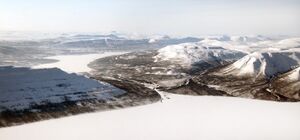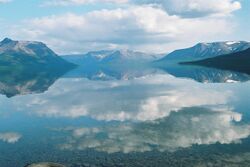Earth:Putorana Plateau
| UNESCO World Heritage Site | |
|---|---|
 | |
| Location | Krasnoyarsk Krai, Russia , Asia |
| Criteria | Natural: (vii), (ix) |
| Reference | 1234rev |
| Inscription | 2010 (34th session) |
| Area | 1,887,251 ha (4,663,500 acres) |
| Buffer zone | 1,773,300 ha (4,382,000 acres) |
| Website | zapovedsever |
| Coordinates | [ ⚑ ] : 69°2′49″N 94°9′29″E / 69.04694°N 94.15806°E |
The Putorana Plateau (Russian: Плато Путорана, romanized: Plato Putorana) or the Putorana Mountains is a high-lying basalt plateau, a mountainous area at the northwestern edge of the Central Siberian Plateau, to the south from Taymyr Peninsula. The highest mountain in the range is Mount Kamen which stands 1,700 m (5,600 ft) above sea level.
The plateau is composed of Siberian Traps. The nearest large settlement is the closed city of Norilsk. The area contains some of the largest known nickel deposits in the world. Russia's geographical center, Lake Vivi, is situated on the plateau, as is the Talnikovy Waterfall, touted as the highest waterfall in Asia.
The lakes such as the Dyupkun are large and form whole ecosystems, which spread over many tens of kilometers. “Putorana” is from the native language of the Evenks and translates to “the country of lakes with steep banks”. The more than 25,000 lakes are between 180 and 420 m (590 and 1,400 ft) deep, and together they form the second-largest store of fresh water in Russia by capacity after Lake Baikal.[1]
The Putorana Nature Reserve, established in 1988 and administered from Norilsk, covers some 1,887,251 ha (4,663,500 acres) with a buffer zone of 1,773,300 ha (4,382,000 acres). It was set up to protect the world's largest herd of reindeer, as well as snow sheep.
In July 2010, the Putorana Reserve was inscribed on the World Heritage List as "a complete set of subarctic and arctic ecosystems in an isolated mountain range, including pristine taiga, forest tundra, tundra and arctic desert systems, as well as untouched cold-water lake and river systems".[2]
Natural resources
The Plateau's minerals include igneous basalt rocks, iron ores (magnetite and hematite), silicates (prehnite, zeolite), apatites, perovskites and highly saturated copper and nickel ores. The natural resources are presented by abundant water and coal.[3]
References
External links
- Official website of the Putorana Nature Reserve
- The Putorana Plateau Natural Heritage Protection Fund
- The Best Travel Guide in Putorana Plateau





